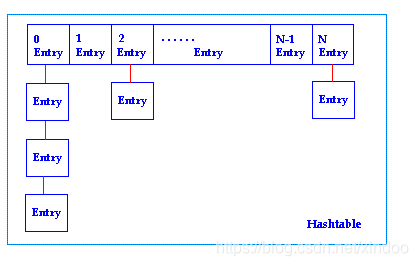Dict在redis中是最为核心的一个数据结构,因为它承载了redis里的所有数据,你可以简单粗暴的认为redis就是一个大的dict,里面存储的所有的key-value。
redis中dict的本质其实就是一个hashtable,所以它也需要考虑所有hashtable所有的问题,如何组织K-V、如何处理hash冲突、扩容策略及扩容方式……。实际上Redis中hashtable的实现方式就是普通的hashtable,但Redis创新的引入了渐进式hash以减小hashtable扩容是对性能带来的影响,接下来我们就来看看redis中hashtable的具体实现。
Redis中Dict的实现
dict的定义在dict.h中,其各个字段及其含义如下:
typedef struct dict {
dictType *type; // dictType结构的指针,封装了很多数据操作的函数指针,使得dict能处理任意数据类型(类似面向对象语言的interface,可以重载其方法)
void *privdata; // 一个私有数据指针(privdata),由调用者在创建dict的时候传进来。
dictht ht[2]; // 两个hashtable,ht[0]为主,ht[1]在渐进式hash的过程中才会用到。
long rehashidx; /* 增量hash过程过程中记录rehash执行到第几个bucket了,当rehashidx == -1表示没有在做rehash */
unsigned long iterators; /* 正在运行的迭代器数量 */
} dict;
重点介绍下dictType *type字段(个人感觉命名为type不太合适),其作用就是为了让dict支持各种数据类型,因为不同的数据类型需要对应不同的操作函数,比如计算hashcode 字符串和整数的计算方式就不一样, 所以dictType通过函数指针的方式,将不同数据类型的操作都封装起来。从面相对象的角度来看,可以把dictType当成dict中各种数据类型相关操作的interface,各个数据类型只需要实现其对应的数据操作就行。 dictType中封装了以下几个函数指针。
typedef struct dictType {
uint64_t (*hashFunction)(const void *key); // 对key生成hash值
void *(*keyDup)(void *privdata, const void *key); // 对key进行拷贝
void *(*valDup)(void *privdata, const void *obj); // 对val进行拷贝
int (*keyCompare)(void *privdata, const void *key1, const void *key2); // 两个key的对比函数
void (*keyDestructor)(void *privdata, void *key); // key的销毁
void (*valDestructor)(void *privdata, void *obj); // val的销毁
} dictType;
dict中还有另外一个重要的字段dictht ht[2],dictht其实就是hashtable,但这里为什么是ht[2]? 这就不得不提到redis dict的渐进式hash,dict的hashtable的扩容不是一次性完成的,它是先建立一个大的新的hashtable存放在ht[1]中,然后逐渐把ht[0]的数据迁移到ht[1]中,rehashidx就是ht[0]中数据迁移的进度,渐进式hash的过程会在后文中详解。
这里我们来看下dictht的定义:
typedef struct dictht {
dictEntry **table; // hashtable中的连续空间
unsigned long size; // table的大小
unsigned long sizemask; // hashcode的掩码
unsigned long used; // 已存储的数据个数
} dictht;
其中dictEntry就是对dict中每对key-value的封装,除了具体的key-value,其还包含一些其他信息,具体如下:
typedef struct dictEntry {
void *key;
union { // dictEntry在不同用途时存储不同的数据
void *val;
uint64_t u64;
int64_t s64;
double d;
} v;
struct dictEntry *next; // hash冲突时开链,单链表的next指针
} dictEntry;
dict中的hashtable在出现hash冲突时采用的是开链方式,如果有多个entry落在同一个bucket中,那么他们就会串成一个单链表存储。
如果我们将dict在内存中的存储绘制出来,会是下图这个样子。

扩容
在看dict几个核心API实现之前,我们先来看下dict的扩容,也就是redis的渐进式hash。 何为渐进式hash?redis为什么采用渐进式hash?渐进式hash又是如何实现的?
要回答这些问题,我们先来考虑下hashtable扩容的过程。如果熟悉java的同学可能知道,java中hashmap的扩容是在数据元素达到某个阈值后,新建一个更大的空间,一次性把旧数据搬过去,搬完之后再继续后续的操作。如果数据量过大的话,HashMap扩容是非常耗时的,所有有些编程规范推荐new HashMap时最好指定其容量,防止出现自动扩容。
但是redis在新建dict的时候,没法知道数据量大小,如果直接采用java hashmap的扩容方式,因为redis是单线程的,势必在扩容过程中啥都干不了,阻塞掉后面的请求,最终影响到整个redis的性能。如何解决? 其实也很简单,就是化整为零,将一次大的扩容操作拆分成多次小的步骤,一步步来减少扩容对其他操作的影响,其具体实现如下:
上文中我们已经看到了在dict的定义中有个dictht ht[2],dict在扩容过程中会有两个hashtable分别存储在ht[0]和ht[1]中,其中ht[0]是旧的hashtable,ht[1]是新的更大的hashtable。
/* 检查是否dict需要扩容 */
static int _dictExpandIfNeeded(dict *d)
{
/* 已经在渐进式hash的流程中了,直接返回 */
if (dictIsRehashing(d)) return DICT_OK;
/* If the hash table is empty expand it to the initial size. */
if (d->ht[0].size == 0) return dictExpand(d, DICT_HT_INITIAL_SIZE);
/* 当配置了可扩容时,容量负载达到100%就扩容。配置不可扩容时,负载达到5也会强制扩容*/
if (d->ht[0].used >= d->ht[0].size &&
(dict_can_resize ||
d->ht[0].used/d->ht[0].size > dict_force_resize_ratio))
{
return dictExpand(d, d->ht[0].used*2); // 扩容一倍容量
}
return DICT_OK;
}
Redis在每次查找某个key的索引下标时都会检查是否需要对ht[0]做扩容,如果配置的是可以扩容 那么当hashtable使用率超过100%(uesed/size)就触发扩容,否则使用率操作500%时强制扩容。执行扩容的代码如下:
/* dict的创建和扩容 */
int dictExpand(dict *d, unsigned long size)
{
/* 如果size比hashtable中的元素个数还小,那size就是无效的,直接返回error */
if (dictIsRehashing(d) || d->ht[0].used > size)
return DICT_ERR;
dictht n; /* 新的hashtable */
// 扩容时新table容量是大于当前size的最小2的幂次方,但有上限
unsigned long realsize = _dictNextPower(size);
// 如果新容量和旧容量一致,没有必要继续执行了,返回err
if (realsize == d->ht[0].size) return DICT_ERR;
/* 新建一个容量更大的hashtable */
n.size = realsize;
n.sizemask = realsize-1;
n.table = zcalloc(realsize*sizeof(dictEntry*));
n.used = 0;
// 如果是dict初始化的情况,直接把新建的hashtable赋值给ht[0]就行
if (d->ht[0].table == NULL) {
d->ht[0] = n;
return DICT_OK;
}
// 非初始化的情况,将新表赋值给ht[1], 然后标记rehashidx 0
d->ht[1] = n;
d->rehashidx = 0; // rehashidx表示当前rehash到ht[0]的下标位置
return DICT_OK;
}
这里dictExpand只是创建了新的空间,将rehashidx标记为0(rehashidx==-1表示不在rehash的过程中),并未对ht[0]中的数据迁移到ht[1]中。数据迁移的逻辑都在_dictRehashStep()中。 _dictRehashStep()是只迁移一个bucket,它在dict的查找、插入、删除的过程中都会被调到,每次调用至少迁移一个bucket。 而dictRehash()是_dictRehashStep()的具体实现,代码如下:
/* redis渐进式hash,采用分批的方式,逐渐将ht[0]依下标转移到ht[2],避免了hashtable扩容时大量
* 数据迁移导致的性能问题
* 参数n是指这次rehash只做n个bucket */
int dictRehash(dict *d, int n) {
int empty_visits = n*10; /* 最大空bucket数量,如果遇到empty_visits个空bucket,直接结束当前rehash的过程 */
if (!dictIsRehashing(d)) return 0;
while(n-- && d->ht[0].used != 0) {
dictEntry *de, *nextde;
/* Note that rehashidx can't overflow as we are sure there are more
* elements because ht[0].used != 0 */
assert(d->ht[0].size > (unsigned long)d->rehashidx);
while(d->ht[0].table[d->rehashidx] == NULL) {
d->rehashidx++;
if (--empty_visits == 0) return 1; // 如果遇到了empty_visits个空的bucket,直接结束
}
// 遍历当前bucket中的链表,直接将其移动到新的hashtable中
de = d->ht[0].table[d->rehashidx];
/* 把所有的key从旧的hash桶移到新的hash桶中 */
while(de) {
uint64_t h;
nextde = de->next;
/* 获取到key在新hashtable中的下标 */
h = dictHashKey(d, de->key) & d->ht[1].sizemask;
de->next = d->ht[1].table[h];
d->ht[1].table[h] = de;
d->ht[0].used--;
d->ht[1].used++;
de = nextde;
}
d->ht[0].table[d->rehashidx] = NULL;
d->rehashidx++;
}
/* 检测是否已对全表做完了rehash */
if (d->ht[0].used == 0) {
zfree(d->ht[0].table); // 释放旧ht所占用的内存空间
d->ht[0] = d->ht[1]; // ht[0]始终是在用ht,ht[1]始终是新ht,ht0全迁移到ht1后会交换下
_dictReset(&d->ht[1]);
d->rehashidx = -1;
return 0; // 如果全表hash完,返回0
}
/* 还需要继续做hash返回1 */
return 1;
}
可以看出,rehash就是分批次把ht[0]中的数据搬到ht[1]中,这样将原有的一个大操作拆分为很多个小操作逐步进行,避免了redis发生dict扩容是瞬时不可用的情况,缺点是在redis扩容过程中会占用俩份存储空间,而且占用时间会比较长。
核心API
插入
/* 向dict中添加元素 */
int dictAdd(dict *d, void *key, void *val)
{
dictEntry *entry = dictAddRaw(d,key,NULL);
//
if (!entry) return DICT_ERR;
dictSetVal(d, entry, val);
return DICT_OK;
}
/* 添加和查找的底层实现:
* 这个函数只会返回key对应的entry,并不会设置key对应的value,而是把设值权交给调用者。
*
* 这个函数也作为一个API直接暴露给用户调用,主要是为了在dict中存储非指针类的数据,比如
* entry = dictAddRaw(dict,mykey,NULL);
* if (entry != NULL) dictSetSignedIntegerVal(entry,1000);
*
* 返回值:
* 如果key已经存在于dict中了,直接返回null,并把已经存在的entry指针放到&existing里。否则
* 为key新建一个entry并返回其指针。
*/
dictEntry *dictAddRaw(dict *d, void *key, dictEntry **existing)
{
long index;
dictEntry *entry;
dictht *ht;
if (dictIsRehashing(d)) _dictRehashStep(d);
/* 获取到新元素的下标,如果返回-1标识该元素已经存在于dict中了,直接返回null */
if ((index = _dictKeyIndex(d, key, dictHashKey(d,key), existing)) == -1)
return NULL;
/* 否则就给新元素分配内存,并将其插入到链表的头部(一般新插入的数据被访问的频次会更高)*/
ht = dictIsRehashing(d) ? &d->ht[1] : &d->ht[0];
entry = zmalloc(sizeof(*entry));
entry->next = ht->table[index];
ht->table[index] = entry;
ht->used++;
/* 如果是新建的entry,需要把key填进去 */
dictSetKey(d, entry, key);
return entry;
}
插入过程也比较简单,就是先定位bucket的下标,然后插入到单链表的头节点,注意这里也需要考虑到rehash的情况,如果是在rehash过程中,新数据一定是插入到ht[1]中的。
查找
dictEntry *dictFind(dict *d, const void *key)
{
dictEntry *he;
uint64_t h, idx, table;
if (dictSize(d) == 0) return NULL; /* dict为空 */
if (dictIsRehashing(d)) _dictRehashStep(d);
h = dictHashKey(d, key);
// 查找的过程中,可能正在rehash中,所以新老两个hashtable都需要查
for (table = 0; table <= 1; table++) {
idx = h & d->ht[table].sizemask;
he = d->ht[table].table[idx];
while(he) {
if (key==he->key || dictCompareKeys(d, key, he->key))
return he;
he = he->next;
}
// 如果ht[0]中没找到,且不再rehas中,就不需要继续找了ht[1]了。
if (!dictIsRehashing(d)) return NULL;
}
return NULL;
}
查找的过程比较简单,就是用hashcode做定位,然后遍历单链表。但这里需要考虑到如果是在rehash过程中,可能需要查找ht[2]中的两个hashtable。
删除
/* 查找并删除一个元素,是dictDelete()和dictUnlink()的辅助函数。*/
static dictEntry *dictGenericDelete(dict *d, const void *key, int nofree) {
uint64_t h, idx;
dictEntry *he, *prevHe;
int table;
if (d->ht[0].used == 0 && d->ht[1].used == 0) return NULL;
if (dictIsRehashing(d)) _dictRehashStep(d);
h = dictHashKey(d, key);
// 这里也是需要考虑到rehash的情况,ht[0]和ht[1]中的数据都要删除掉
for (table = 0; table <= 1; table++) {
idx = h & d->ht[table].sizemask;
he = d->ht[table].table[idx];
prevHe = NULL;
while(he) {
if (key==he->key || dictCompareKeys(d, key, he->key)) {
/* 从列表中unlink掉元素 */
if (prevHe)
prevHe->next = he->next;
else
d->ht[table].table[idx] = he->next;
// 如果nofree是0,需要释放k和v对应的内存空间
if (!nofree) {
dictFreeKey(d, he);
dictFreeVal(d, he);
zfree(he);
}
d->ht[table].used--;
return he;
}
prevHe = he;
he = he->next;
}
if (!dictIsRehashing(d)) break;
}
return NULL; /* 没找到key对应的数据 */
}
其它API
其他的API实现都比较简单,我在dict.c源码中做了大量的注释,有兴趣可以自行阅读下,我这里仅列举并说明下其大致的功能。
dict *dictCreate(dictType *type, void *privDataPtr); // 创建dict
int dictExpand(dict *d, unsigned long size); // 扩缩容
int dictAdd(dict *d, void *key, void *val); // 添加k-v
dictEntry *dictAddRaw(dict *d, void *key, dictEntry **existing); // 添加的key对应的dictEntry
dictEntry *dictAddOrFind(dict *d, void *key); // 添加或者查找
int dictReplace(dict *d, void *key, void *val); // 替换key对应的value,如果没有就添加新的k-v
int dictDelete(dict *d, const void *key); // 删除某个key对应的数据
dictEntry *dictUnlink(dict *ht, const void *key); // 卸载某个key对应的entry
void dictFreeUnlinkedEntry(dict *d, dictEntry *he); // 卸载并清除key对应的entry
void dictRelease(dict *d); // 释放整个dict
dictEntry * dictFind(dict *d, const void *key); // 数据查找
void *dictFetchValue(dict *d, const void *key); // 获取key对应的value
int dictResize(dict *d); // 重设dict的大小,主要是缩容用的
/************ 迭代器相关 *********** */
dictIterator *dictGetIterator(dict *d);
dictIterator *dictGetSafeIterator(dict *d);
dictEntry *dictNext(dictIterator *iter);
void dictReleaseIterator(dictIterator *iter);
/************ 迭代器相关 *********** */
dictEntry *dictGetRandomKey(dict *d); // 随机返回一个entry
dictEntry *dictGetFairRandomKey(dict *d); // 随机返回一个entry,但返回每个entry的概率会更均匀
unsigned int dictGetSomeKeys(dict *d, dictEntry **des, unsigned int count); // 获取dict中的部分数据
本文是Redis源码剖析系列博文,同时也有与之对应的Redis中文注释版,有想深入学习Redis的同学,欢迎star和关注。
Redis中文注解版仓库:https://github.com/xindoo/Redis
Redis源码剖析专栏:https://zxs.io/s/1h
如果觉得本文对你有用,欢迎一键三连。
本文来自https://blog.csdn.net/xindoo